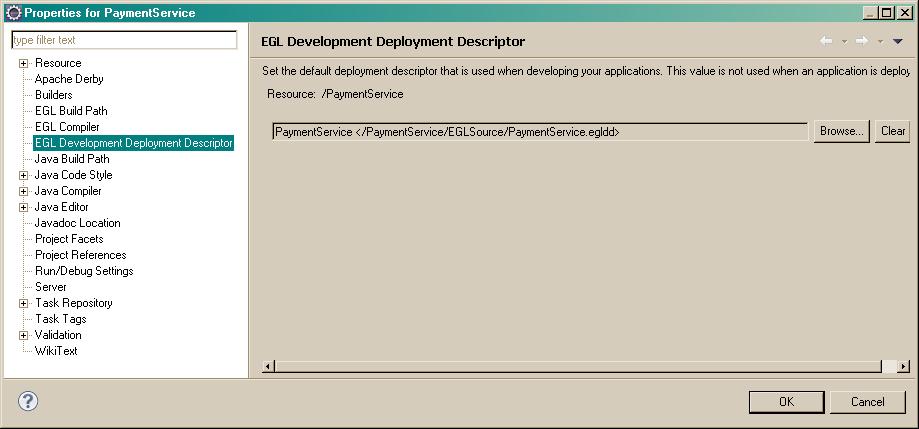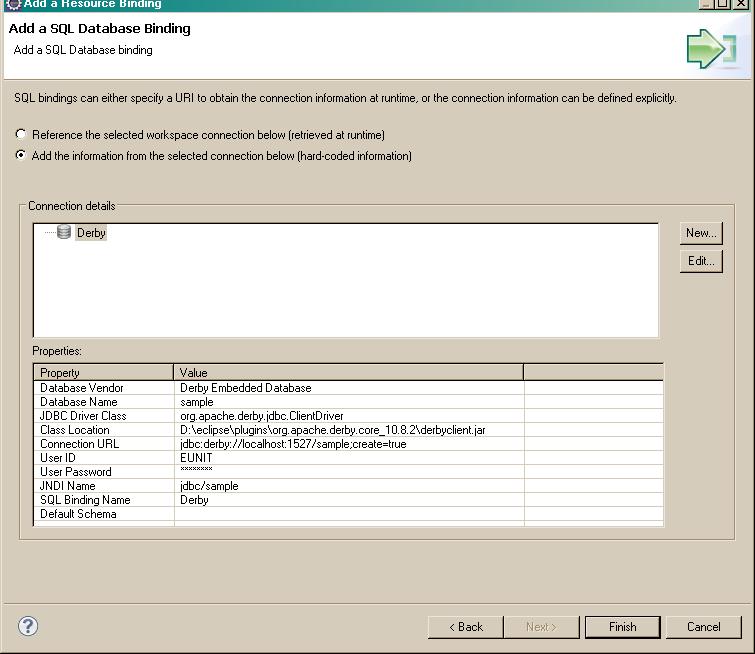Notice: This Wiki is now read only and edits are no longer possible. Please see: https://gitlab.eclipse.org/eclipsefdn/helpdesk/-/wikis/Wiki-shutdown-plan for the plan.
EDT:Tutorial: RUI With DataBase Lesson 6
Access a database with EGL Rich UI
| < Previous | Next > |
Lesson 6: Add code for the service functions
In EGL, I/O statements such as add and get access data that resides in different kinds of persistent data storage, from file systems to queues to databases. The coding is similar for the different cases.
In this lesson, you add functions that access rows in a relational database. Add the functions in order, before the final end statement in SQLService.egl.
Create binding to database connection
In Lesson 3, you defined a database connection named Derby. Use these steps to use the Derby connection from your SQL service.
Note: The SQL binding will already be included in the deployment descriptor if you checked Save data source configuration to deployment descriptor when retrieving the table definition from the database.
- EGL projects have associated deployment descriptor (.egldd) files. To see the name of the file that is in use at development time, right click PaymentService in the project explorer, click Properties, and at the Properties dialog, click EGL Development Deployment Descriptor.
PaymentService.egldd was specified as the deployment descriptor when you defined the project.
Click OK to close the window.
- In the PaymentService project, right-click the PaymentService.egldd file and open the file with the EGL Deployment Descriptor editor.

- Select the Resource Bindings tab.
- Add a new resource binding named Derby of binding type SQL database binding.
- If you are using EDT 0.7.0, select radio button Add the information from the selected connection below (hard-coded information). The runtime connection is not supported in EDT 7.0 or earlier.
- If you are using EDT 0.8.0, you will want to select radio button Reference the selected workspace connection below (retrieved at runtime). When the application is deployed to the application server, the connection will be accessed at runtime using a JNDI name as a resource reference. If you deploy to an Apache Tomcat Server, EGL deployment uses both the JNDI name and the connection details to create the JNDI <resource-ref> entry in the WEB-INF\web.xml file and the <resource> entry in the META-INF\context.xml file that will be used at run time. The only additional thing you need to do is make sure the derbyclient.jar file is copied to the Tomcat lib directory.
- Select Derby connection details.
- Clink on Finish.

- Close file PaymentServices.egldd
Using an SQL resource binding in service program
Insert an SQLDataSource variable in the service program following the program name:
- For EDT .7:
package services;
service SQLService
ds SQLDataSource? { @Resource { bindingKey="Derby" } } ; // EDT 0.7.O syntax
end
- For EDT .8:
package services;
service SQLService
ds SQLDataSource? { @Resource { uri="binding:Derby" } } ; // EDT 0.8.O syntax
end
The syntax directs the service to use the binding named "Derby" defined as a resource in the deployment descriptor file associated with the service project.
Handling SQL exceptions
SQL operations can fail for a multitude of reasons. For our simple example, our service will catch all SQL and log all SQL exceptions on the server and then throw the exception back to the service client. It will also log each service invocation.
Copy and paste these logging functions to the service program before the final end statement:
logActive boolean = true;
activeService string;
private function logEntry(serviceFunction string in)
activeService = serviceFunction;
log("Entry: SQLService, " + serviceFunction);
end
private function logException(ex sqlException?)
accumulatedMessage string = "Exception: SQLService, " + activeService;
while(ex != null)
accumulatedMessage = accumulatedMessage + ", SQLSTATE = " +
ex.SQLState + ", message = " + ex.message;
ex = ex.nextException;
end
log(accumulatedMessage);
throw new anyException{message = accumulatedMessage};
end
private function log(text string in)
if(logActive)
sysLib.writeStdOut(text);
end
end
Add a payment record
Include a function to the service program that uses the add statement to insert a new row to the database.
To code the function:
- In the EGL editor, copy and paste the following lines into SQLService.egl before the logging functions:
function addPayment(newPayment paymentRec in)
logEntry ( "addPayment" ) ;
try
add newPayment to ds ;
onException(ex sqlException)
logException(ex);
end
end
- Before you continue, you must resolve the reference to the paymentRec Record type. You can automatically create import statements by using the Organize Imports feature. Right-click any blank area in the editor and click EGL Source > Organize Imports.
- EGL adds the following statement to the beginning of the file:
import records.paymentRec;
- The reference is now resolved. You will use this feature often, whether by selecting the menu item or by pressing Ctrl-Shift-O.
- Save the file (Ctrl-S), and then place your cursor anywhere in the add statement. Press keys CTRL-1 and select Add SQL Statement from the popup menu. This feature changes the implicit SQL that underlies the EGL add statement into embedded code that you can modify:
function addPayment(newPayment paymentRec in)
logEntry ( "addPayment" ) ;
try
add newPayment to ds
with #sql{
insert into PAYMENT
(CATEGORY, DESCRIPTION, AMOUNT, FIXED_PAYMENT, DUE_DATE,
PAYEE_NAME, PAYEE_ADDRESS1, PAYEE_ADDRESS2)
values
(?, ?, ?, ?, ?, ?, ?, ?)
};
onException(ex sqlException)
logException(ex);
end
end
Notice the PAYMENT_ID field is not included in the record fields added to the table. The @GeneratedValue annotation for the field in the record definition tells the EGL SQL builder not to explicitly add the column.
Related reference
- Help topic: add considerations for SQL
- Help topic: Functions
- Help topic: import
- Help topic: SQL data access
Read all database records
The getAllPayments function uses the get statement with an array object to read all of the records from the table and stores them in an array.
To code the function:
- In the EGL editor, copy and paste the following lines into SQLService.egl before the logging functions:
function getAllPayments() returns(paymentRec[])
payments paymentRec[];
logEntry("getAllPayments");
try
get payments from ds;
onException(ex sqlException)
logException(ex);
end
return(payments);
end
- The EGL get statement generates an SQL SELECT statement to retrieve a result set. When the target of the get statement is a dynamic array of records, EGL retrieves all matching rows from the result set and inserts each successive row into the next array element.
- As with the add statement, you may place the cursor anywhere in the statement and press CNTL-1 to see the SQL statement EGL will use to retrieve the rows. You may again save the default statement and modify it if it does do what you want.
- Save the file.
Related reference
- Help topic: get considerations for SQL
Replace a record
The editPayment function replaces an existing row in the database with an edited version. The default statement replaces all records in the table that have key values equal to the contents of the key fields in the record variable. Key fields are those fields declared with the @Id attribute (field payment_id in our example).
To code the function:
- In the EGL editor, copy and paste the following lines into SQLService.egl before the logging functions:
function editPayment(chgPayment paymentRec in)
logEntry("editPayment");
try
replace chgPayment to ds;
onException(ex SQLException)
logException(ex);
end
end
The EGL replace statement generates an SQL UPDATE statement.
- Save the file.
Related reference
- Help topic: replace considerations for SQL
Delete a record
The deletePayment function deletes the specified record from the table.
To code the function:
- In the EGL editor, copy and paste the following lines into SQLService.egl before the logging functions:
function deletePayment(delPayment paymentRec in)
logEntry("deletePayment");
try
delete delPayment from ds;
onException(ex SQLException)
if(ex.SQLState != "02000") // sql state is five digits
logException(ex);
end
end
end
- The EGL delete statement generates an SQL DELETE statement. If no rows are present, the Derby database returns an SQLState value of "02000", and the EGL runtime code throws an exception that the function catches: that is, processes, in some onException logic.
- When a function catches but ignores an exception, processing continues without interruption. That rule applies to the preceding logic, when the value of SQLState is "02000". When a function uses the throw statement to throw an exception, the exception stays active. That rule also applies to the preceding logic, when the value of SQLState is other than "02000".
- At run time, if a service does not handle an exception, the service requester receives an exception of type ServiceInvocationException. Incidentally, if the service cannot be accessed, the requester receives an exception of type ServiceInvocationException or ServiceBindingException, depending on the details of the error.
- Save the file.
Related reference
- Help topic: delete considerations for SQL
- Help topic: Exception handling
Create test data
The createDefaultTable function creates a set of data for testing your completed application.
To code the function:
- In the EGL editor, copy and paste the following lines into SQLService.egl before the logging functions:
function createDefaultTable() returns(paymentRec[])
payments paymentRec[];
logEntry("createDefaultTable");
try
try
execute from ds
with #sql{
delete from PAYMENT
};
onException(ex SQLException)
if(ex.SQLState != "02000") // sqlState is five digits
throw ex;
end
end
ispDate date = dateTimeLib.dateFromGregorian(20140405);
addPayment(new paymentRec{category = 1, description = "Apartment"
, amount = 880, fixedPayment = yes, dueDate = new date
, payeeName = "A Jones", payeeAddress1 = "100 Jones Dr"
, payeeAddress2 = "Jonesboro, NC"
});
addPayment(new paymentRec{category = 2, description = "Groceries"
, amount = 450, fixedPayment = no, dueDate = new date
, payeeName = "B Jones", payeeAddress1 = "200 Jones Dr"
, payeeAddress2 = "Jonesboro, NC"
});
addPayment(new paymentRec{category = 5, description = "ISP"
, amount = 19.99, fixedPayment = no, dueDate = ispDate
, payeeName = "C Jones", payeeAddress1 = "300 Jones Dr"
, payeeAddress2 = "Jonesboro, NC"
});
payments = getAllPayments();
onException(ex anyException)
logException(ex);
end
return(payments);
end
The code acts as follows:
- The EGL execute statement runs a literal SQL statement that deletes all rows from the PAYMENT table.
- The ispDate variable receives a date value from the dateTimeLib.dateValueFromGregorian() system function. The content of the variable is then in a format that is appropriate for insertion into the
dueDatefield in the database. - The addPayment function is repeatedly invoked to add new rows to the PAYMENT table.
- The call to the getAllPayments function returns an array of rows that were retrieved from the table.
- Press Ctrl-Shift-F to format the code. If you see any red Xs, compare your code with the finished code in Code for SQLService.egl after lesson 6
- Save and close the file.
Related reference
- Help topic: execute considerations for SQL
- Help topic: dateValueFromGregorian()
Lesson checkpoint
You learned how to complete the following tasks:
- Add embedded SQL code to a program and modify that code
- Automatically create and organize import statements
In the next lesson, you will create a widget to hold the table of expense data.
| < Previous | Next > |
